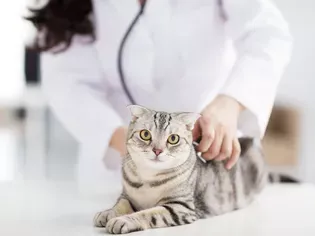Hyperlipidemia in Cats
Updated on 04/26/24

Unveiling the Silent Danger: Hyperlipidemia in Cats
Cats, our beloved companions, are often prone to health conditions that go unnoticed. Hyperlipidemia, an insidious increase in blood lipid levels, is one such condition. This blog post delves into the world of feline hyperlipidemia, helping you understand its causes, symptoms, and potential consequences. By arming yourself with knowledge, you can play a vital role in ensuring the well-being of your furry friend.
Understanding Hyperlipidemia: The Basics
Lipids, commonly known as fats, play a crucial role in the feline body. They provide energy, insulation, and are essential for hormone production. However, excessive levels of lipids in the blood can lead to a condition called hyperlipidemia. This condition can disrupt the normal functioning of the body, potentially leading to severe health problems if left untreated.
Causes of Hyperlipidemia in Cats
Hyperlipidemia in cats can stem from a variety of factors, both primary and secondary.
Primary Hyperlipidemia:
* Inherited: Some cats inherit a genetic predisposition to high blood lipid levels.
* Idiopathic: In many cases, the exact cause of primary hyperlipidemia remains unknown.
Secondary Hyperlipidemia:
* Diabetes mellitus: Diabetes can lead to increased production of triglycerides, a type of lipid.
* Hypothyroidism: Low thyroid hormone levels can slow down metabolism and increase lipid levels.
* Chronic pancreatitis: Inflammation of the pancreas can impair lipid metabolism.
* Kidney disease: Impaired kidney function can affect lipid clearance.
* Medications: Certain medications, such as corticosteroids, can raise lipid levels.
* Obesity: Excess weight can contribute to hyperlipidemia.
Symptoms of Hyperlipidemia in Cats
Hyperlipidemia often goes undetected in cats, as it typically does not manifest with noticeable symptoms. However, in some cases, cats may exhibit:
* Lethargy: Decreased energy levels
* Weight loss: Despite normal or increased appetite
* Vomiting: Occasional vomiting of clear or foamy liquid
* Jaundice: Yellowing of the skin, gums, or whites of the eyes
Consequences of Untreated Hyperlipidemia in Cats
If left untreated, hyperlipidemia can lead to serious health complications, including:
* Pancreatitis: Inflammation of the pancreas
* Hepatic lipidosis: Fatty liver disease
* Cardiovascular disease: Increased risk of heart disease
* Skin and coat problems: Dry, flaky skin and dull coat
* Neurological issues: Potential neurological complications in severe cases
Diagnosis and Treatment of Hyperlipidemia in Cats
Diagnosing hyperlipidemia in cats involves a combination of:
* Physical examination: Your veterinarian will assess your cat's overall health and weight.
* Blood tests: A blood test called a lipid profile measures blood lipid levels.
* Urinalysis: This test can help rule out underlying kidney disease.
* Ultrasound: An ultrasound of the abdomen may be performed to visualize the liver and pancreas.
Treatment for hyperlipidemia typically involves:
* Dietary changes: A diet low in fat and high in fiber can help reduce lipid levels.
* Medication: Prescription medications may be necessary to lower lipid levels, such as cholesterol-lowering drugs.
* Weight management: Maintaining a healthy weight can significantly improve lipid profiles.
* Underlying disease treatment: If hyperlipidemia is secondary to another condition, treating that condition may help resolve the lipid issue.
Preventive Measures for Hyperlipidemia in Cats
While some cases of hyperlipidemia are unavoidable, there are steps you can take to reduce your cat's risk:
* Feed a healthy diet: Choose a high-quality cat food that is low in fat and high in fiber. Avoid giving your cat table scraps or fatty treats.
* Maintain a healthy weight: Obesity is a major risk factor for hyperlipidemia. Help your cat maintain a healthy weight through a balanced diet and regular exercise.
* Regular veterinary check-ups: Regular check-ups with your veterinarian allow for early detection and management of hyperlipidemia and other health conditions.
Conclusion
Hyperlipidemia in cats is a serious condition that can have severe consequences if left untreated. By understanding the causes, symptoms, and potential risks, you can play a vital role in ensuring your cat's long-term health and well-being. If you suspect your cat may have hyperlipidemia, don't hesitate to consult your veterinarian promptly for proper diagnosis and treatment. Remember, prevention is always better than cure, so take proactive steps to maintain your cat's lipid levels within a healthy range.
Explore More Pets

Cat Behavior Problems
How to Stop Aggression in Kittens

Long-Haired Cat Breeds
Siberian Cat: Breed Profile, Characteristics, & Care

Cat Behavior Problems
How to Stop Kittens From Scratching and Biting

Long-Haired Cat Breeds
Turkish Angora: Cat Breed Profile, Characteristics & Care

Basic Training
How to Socialize Your Kitten

Short-Haired Cat Breeds
Cute Pictures & Facts About Calico Cats & Kittens

Litter Box Training
Training Your Kitten to Use the Litter Box

Long-Haired Cat Breeds
10 Fun Facts About White Cats